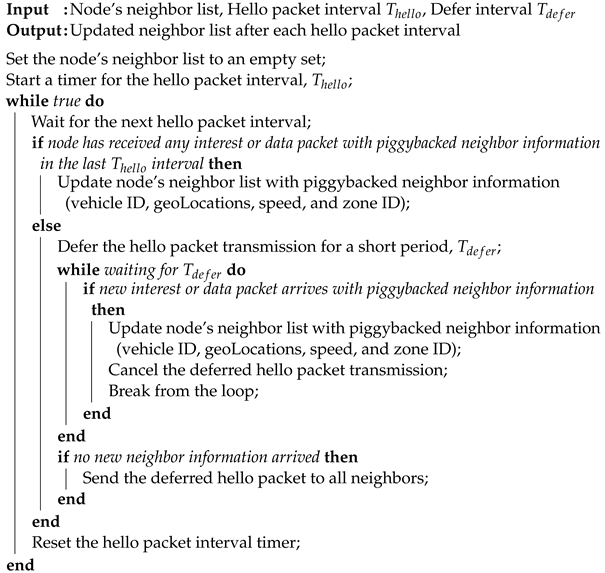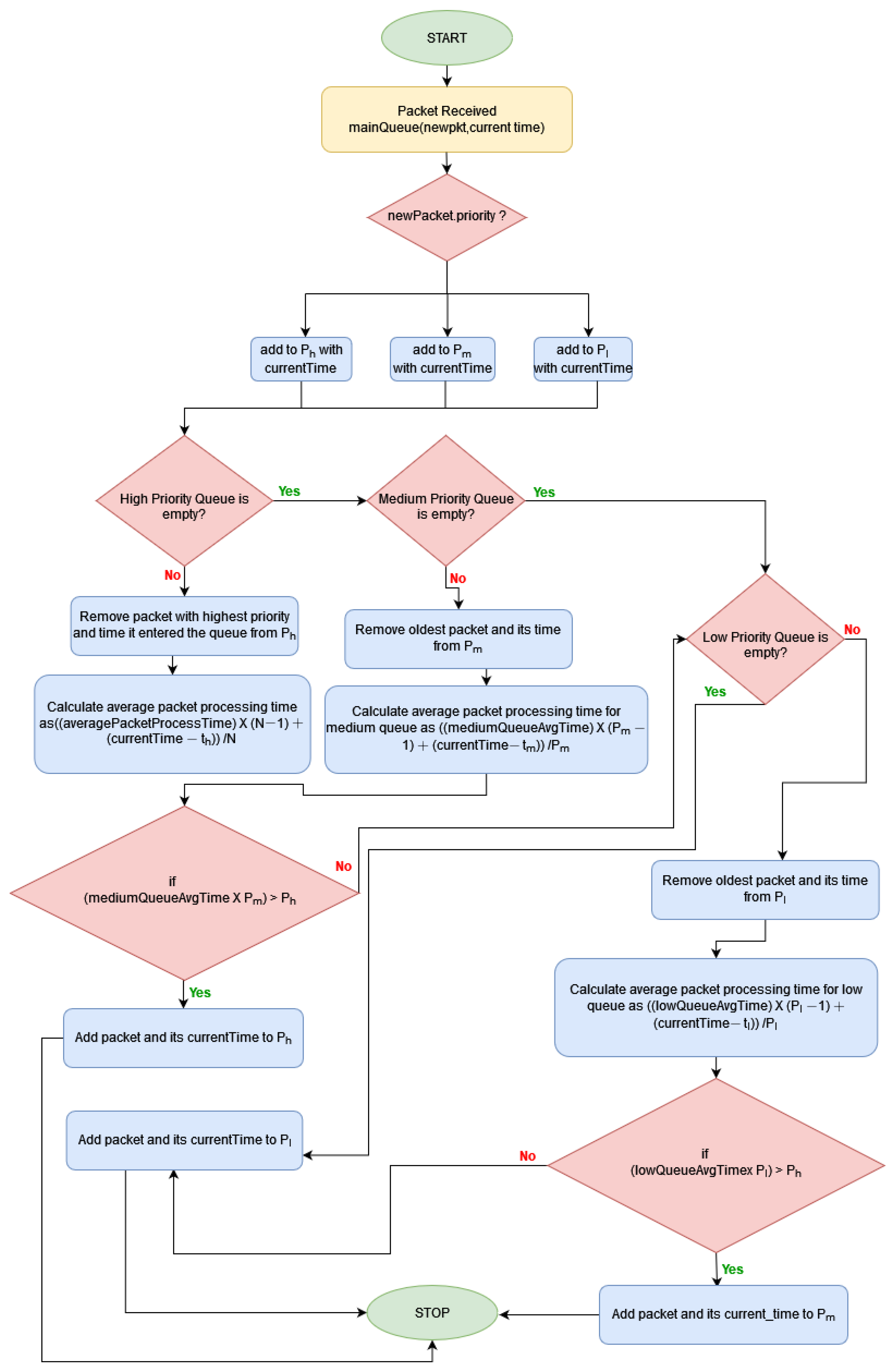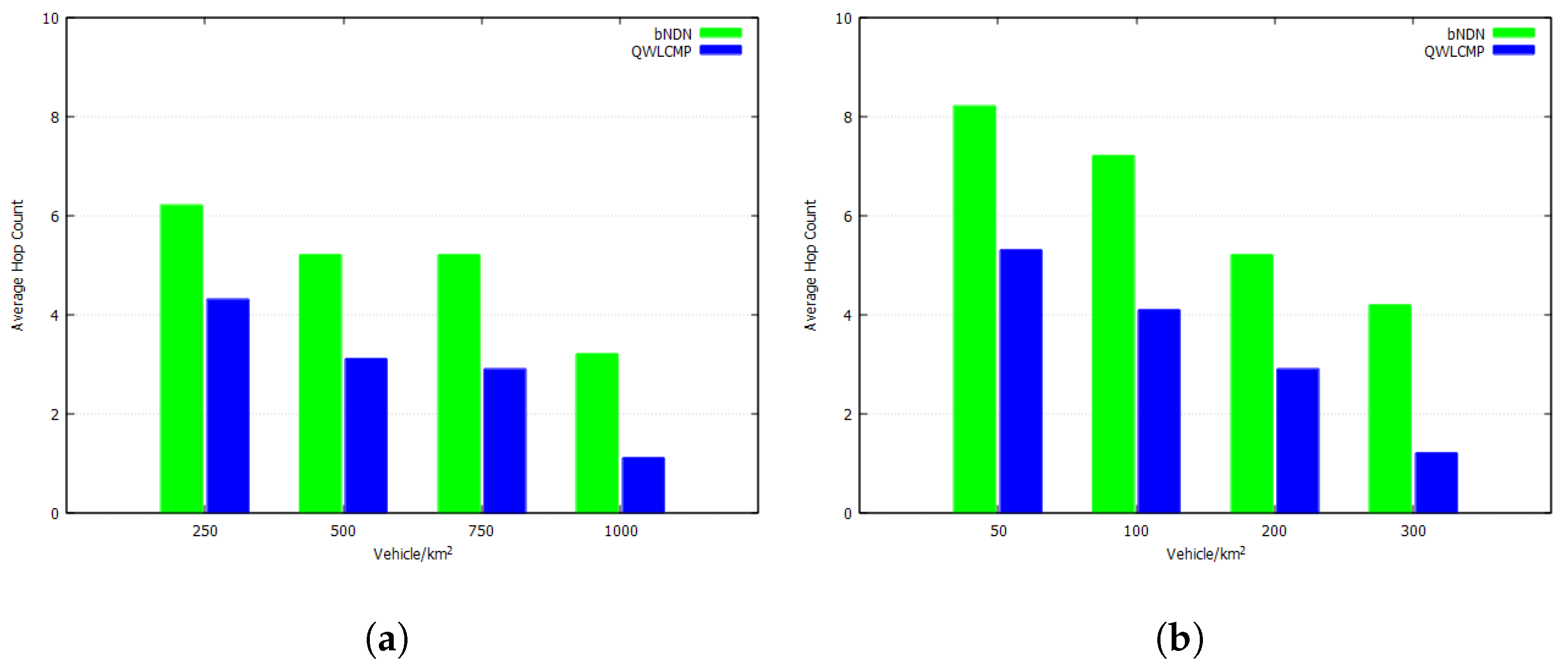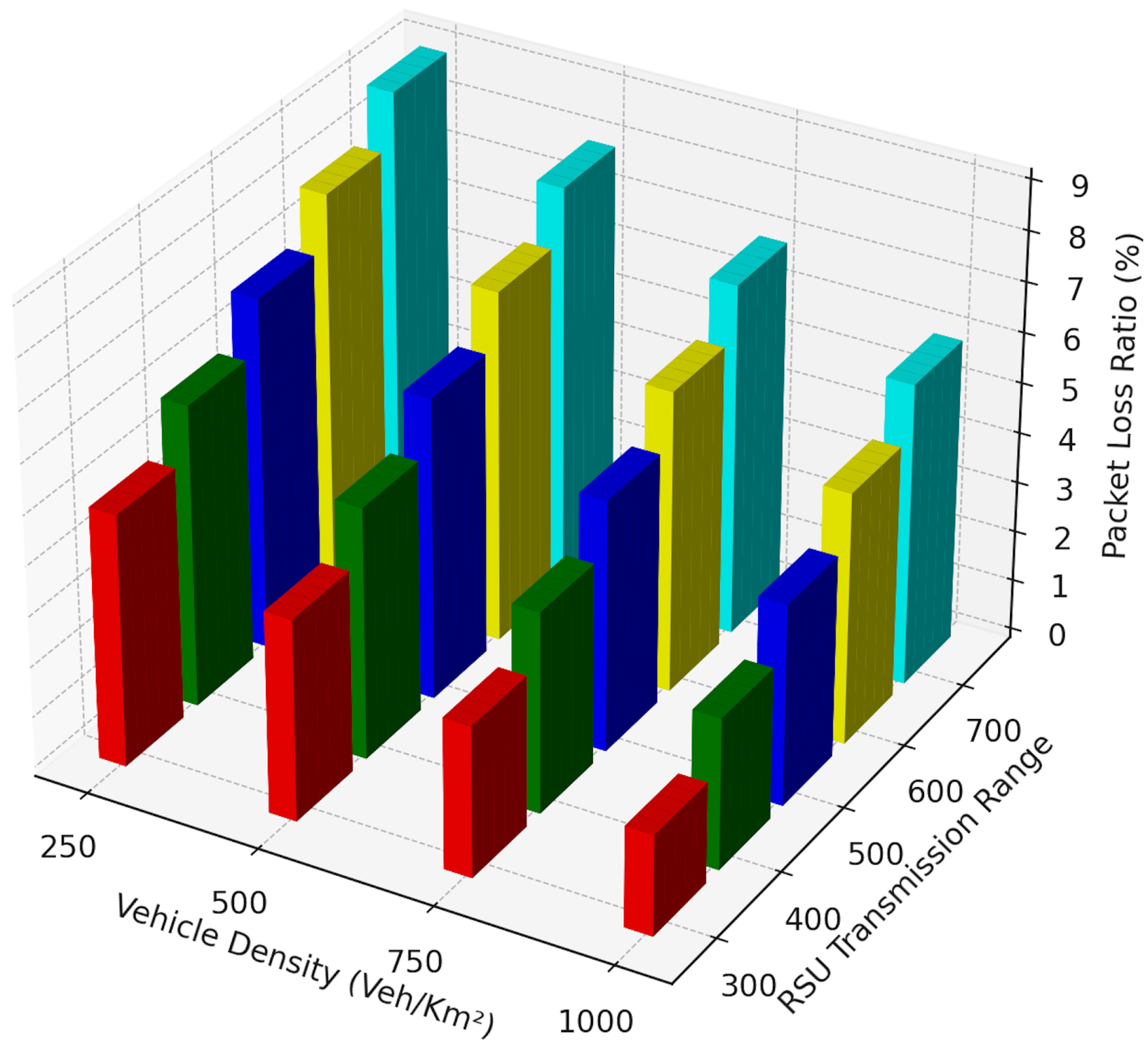QWLCPM: A Method for QoS-Aware Forwarding and Caching Using Simple Weighted Linear Combination and Proximity for Named Data Vehicular Sensor Network
Abstract
1. Introduction
2. Related Work
3. QWLCPM Strategy
4. Forwarding Metrics
4.1. Zone Separation
| Algorithm 1: Zone Assignment and Priority Task Offloading |
 |
4.2. Geolocation
4.3. Vehicle Speed
4.4. Transmission Signal Strength
4.5. Vehicle ID Assignment
5. Forwarding
5.1. Hello Packet
| Algorithm 2: Hello Packet |
 |
5.2. Communication Disruption
5.3. Network Partitions
5.4. Beacon Nodes
| Algorithm 3: Broadcasting Information Using Beacon Nodes in a Vehicular Network |
 |
5.5. Priority Queue Processing
5.6. Packet Type and Naming Scheme
5.7. Finding Stable Nodes
5.8. Weight Determination
- Define the criteria: In this case, the criteria are , Vehicle Speed, GPS values, and vehicle ID.
- Construct pairwise comparison matrices: For each scenario (city and highway), we need to construct a pairwise comparison matrix based on the importance of each criterion relative to the others.
- Calculate priority vectors (weights) for each criterion.
- Perform consistency check to ensure the comparisons make logical sense.
5.8.1. (a) City Scenario Assumptions
- is very important due to close proximity communication but might be slightly affected by obstacles.
- Vehicle speed is less critical because of slower average speeds in city traffic.
- GPS values are essential but are affected by obstacles like buildings.
- Vehicle ID is very important for identifying vehicles in platoons or convoys, especially amidst city obstacles.
5.8.2. (b) Highway Scenario Assumptions
- and GPS values are crucial due to fewer obstacles and the need for precise location and proximity data.
- Vehicle Speed is somewhat less reliable due to higher speeds, making speed less indicative of stability.
- Vehicle ID remains important for identifying vehicles traveling together but might be slightly less critical than in city scenarios due to the open environment.
- vs. Vehicle speed: is more important.
- vs. GPS: Comparable importance.
- vs. vehicle ID: Slightly less important than vehicle ID.
- Vehicle speed vs. GPS: Less important.
- Vehicle speed vs. vehicle ID: Less important.
- GPS vs. vehicle ID: Slightly less important than vehicle ID.
- vs. Vehicle speed: is more important.
- vs. GPS: Comparable importance, but both are highly important.
- vs. vehicle ID: Comparable to vehicle ID.
- Vehicle speed vs. GPS: Less important.
- Vehicle speed vs. vehicle ID: Less important.
- GPS vs. vehicle ID: Slightly less important than GPS.
6. Caching
- Calculate the cache replacement priority as follows:
- (a)
- If the priority of node i is high,
- (b)
- If the priority of node i is medium,
- (c)
- If the priority of node i is low,
- If the node i is in the same zone as its request,
- If the node i is in a different zone from its request,.
7. Content Diversity and Hit Ratio
- The cache has a fixed size and can store a limited number of content items.
- The content items have different priority levels, represented by a probability distribution function.
- Vehicles request content items according to a probability-distribution function that depends on the priority of the items and their diversity.
- C—the cache size in terms of the number of content items;
- —the popularity distribution function of the content items, where p is the popularity level;
- —the probability distribution function of content requests for each vehicle, where d is the diversity level and p is the priority level;
- H—the hit ratio, defined as the fraction of content requests that are satisfied by the cache.
8. Simulation Environment
8.1. Methodology
- Cache hit ratio. The cache hit ratio is a measure of how well a cache performs in a computer system, indicating whether requested data are already stored in the cache.
- Interest satisfaction ratio. In an NDVSN, the ISR is a performance metric used to measure the efficiency of content retrieval in the network. It is calculated as the ratio of the number of interests that are successfully satisfied with a corresponding data packet to the total number of interests sent. A higher ISR means that a larger percentage of interests were successfully satisfied, indicating better performance of the network in terms of content retrieval.
- Hop count. Hop count is an essential metric used in NDN, which measures the number of intermediate network nodes through which a data packet has to pass to reach its destination. The hop count affects the overall performance and efficiency of the network. A higher hop count indicates that data packets have to travel through more intermediate nodes, which can increase the latency and delay in delivering the data. In addition, a higher hop count can increase the likelihood of packet loss or congestion, which can further degrade the network performance.
- Delay. Delay in NDN refers to how long it takes for a data packet to traverse the network from the time it is requested until the time it is received by the requester. Delay is an important performance metric in NDN, as it affects the QoS experienced by users and applications that rely on timely access to data.
- Content diversity. Content diversity in NDN refers to the variety of unique content items that are available in the network. In NDN, data are requested and retrieved based on their names rather than locations or addresses. This means that the network can support a wide range of content types and formats, and users can request and receive specific content items directly from the network.
8.2. Performance Evaluation
9. Conclusions
Author Contributions
Funding
Data Availability Statement
Conflicts of Interest
References
- Jacobson, V.; Smetters, D.K.; Thornton, J.D.; Plass, M.F.; Briggs, N.H.; Braynard, R.L. Networking named content. In Proceedings of the 5th International Conference on Emerging Networking Experiments and Technologies, Rome, Italy, 1–4 December 2009; pp. 1–12. [Google Scholar]
- Liu, X.; Li, Z.; Yang, P.; Dong, Y. Information-centric mobile ad hoc networks and content routing: A survey. Ad Hoc Netw. 2017, 58, 255–268. [Google Scholar] [CrossRef]
- Rashid, S.A.; Hamdi, M.M.; Alani, S. An overview on quality of service and data dissemination in VANETs. In Proceedings of the 2020 International Congress on Human-Computer Interaction, Optimization and Robotic Applications (HORA), Ankara, Turkey, 26–27 June 2020; pp. 1–5. [Google Scholar]
- Zhang, L.; Afanasyev, A.; Burke, J.; Jacobson, V.; Claffy, K.C.; Crowley, P.; Papadopoulos, C.; Wang, L.; Zhang, B. Named data networking. ACM SIGCOMM Comput. Commun. Rev. 2014, 44, 66–73. [Google Scholar] [CrossRef]
- Al-Omaisi, H.; Sundararajan, E.A.; Alsaqour, R.; Abdullah, N.F.; Abdelhaq, M. A survey of data dissemination schemes in vehicular named data networking. Veh. Commun. 2021, 30, 100353. [Google Scholar] [CrossRef]
- Saxena, D.; Raychoudhury, V.; Suri, N.; Becker, C.; Cao, J. Named data networking: A survey. Comput. Sci. Rev. 2016, 19, 15–55. [Google Scholar] [CrossRef]
- Amadeo, M.; Campolo, C.; Molinaro, A. Named data networking for priority-based content dissemination in VANETs. In Proceedings of the 2016 IEEE 27th Annual International Symposium on Personal, Indoor, and Mobile Radio Communications (PIMRC), Valencia, Spain, 4–8 September 2016; pp. 1–6. [Google Scholar]
- Englund, C.; Chen, L.; Vinel, A.; Lin, S.Y. Future applications of VANETs. In Vehicular Ad Hoc Networks: Standards, Solutions, and Research; Springer: Berlin/Heidelberg, Germany, 2015; pp. 525–544. [Google Scholar]
- Khelifi, H.; Luo, S.; Nour, B.; Moungla, H. A QoS-aware cache replacement policy for vehicular named data networks. In Proceedings of the 2019 IEEE Global Communications Conference (GLOBECOM), Big Island, HI, USA, 9–13 December 2019; pp. 1–6. [Google Scholar]
- Singh, P.K.; Nandi, S.K.; Nandi, S. A tutorial survey on vehicular communication state of the art, and future research directions. Veh. Commun. 2019, 18, 100164. [Google Scholar] [CrossRef]
- Ahed, K.; Benamar, M.; Lahcen, A.A.; El Ouazzani, R. Forwarding strategies in vehicular named data networks: A survey. J. King Saud Univ. Comput. Inf. Sci. 2022, 34, 1819–1835. [Google Scholar] [CrossRef]
- Chen, C.; Wang, C.; Qiu, T.; Atiquzzaman, M.; Wu, D.O. Caching in vehicular named data networking: Architecture, schemes and future directions. IEEE Commun. Surv. Tutor. 2020, 22, 2378–2407. [Google Scholar] [CrossRef]
- Tariq, A.; Rehman, R.A.; Kim, B.S. Forwarding strategies in NDN-based wireless networks: A survey. IEEE Commun. Surv. Tutor. 2019, 22, 68–95. [Google Scholar] [CrossRef]
- Abdelaal, M.; Karadeniz, M.; Dürr, F.; Rothermel, K. liteNDN: QoS-aware packet forwarding and caching for named data networks. In Proceedings of the 2020 IEEE 17th Annual Consumer Communications & Networking Conference (CCNC), Las Vegas, NV, USA, 10–13 January 2020; pp. 1–9. [Google Scholar]
- Wang, S.; Wu, W.; Zhi, Z. Varied priority-based data forwarding via NDN in VANET. In Proceedings of the 2019 IEEE SmartWorld, Ubiquitous Intelligence & Computing, Advanced & Trusted Computing, Scalable Computing & Communications, Cloud & Big Data Computing, Internet of People and Smart City Innovation (SmartWorld/SCALCOM/UIC/ATC/CBDCom/IOP/SCI), Leicester, UK, 19–23 August 2019; pp. 574–581. [Google Scholar]
- Huang, W.; Song, T.; Yang, Y.; Zhang, Y. Cluster-based cooperative caching with mobility prediction in vehicular named data networking. IEEE Access 2019, 7, 23442–23458. [Google Scholar] [CrossRef]
- Ashraf, M.; Huang, C.; Raza, K.A.; Huang, S.; Yin, Y.; Wu, D.F. Dynamic cooperative cache management scheme based on social and popular data in vehicular named data network. Wirel. Commun. Mob. Comput. 2022, 2022, 8374181. [Google Scholar] [CrossRef]
- Deng, G.; Wang, L.; Li, F.; Li, R. Distributed probabilistic caching strategy in VANETs through named data networking. In Proceedings of the 2016 IEEE Conference on Computer Communications Workshops (INFOCOM WKSHPS), San Francisco, CA, USA, 10–14 April 2016; pp. 314–319. [Google Scholar]
- Grassi, G.; Pesavento, D.; Pau, G.; Zhang, L.; Fdida, S. Navigo: Interest forwarding by geolocations in vehicular named data networking. In Proceedings of the 2015 IEEE 16th International Symposium on a World of Wireless, Mobile and Multimedia Networks (WoWMoM), Boston, MA, USA, 14–17 June 2015; pp. 1–10. [Google Scholar]
- Deng, G.; Xie, X.; Shi, L.; Li, R. Hybrid information forwarding in VANETs through named data networking. In Proceedings of the 2015 IEEE 26th Annual International Symposium on Personal, Indoor, and Mobile Radio Communications (PIMRC), Hong Kong, China, 30 August–2 September 2015; pp. 1940–1944. [Google Scholar]
- Boukerche, A.; Coutinho, R.W.; Yu, X. LISIC: A link stability-based protocol for vehicular information-centric networks. In Proceedings of the 2017 IEEE 14th International Conference on Mobile Ad Hoc and Sensor Systems (MASS), Orlando, FL, USA, 22–25 October 2017; pp. 233–240. [Google Scholar]
- Ahmed, S.H.; Bouk, S.H.; Kim, D. RUFS: RobUst forwarder selection in vehicular content-centric networks. IEEE Commun. Lett. 2015, 19, 1616–1619. [Google Scholar] [CrossRef]
- Wang, X.; Liu, W.; Yang, L.; Zhang, W.; Peng, C. A new content-centric routing protocol for vehicular ad hoc networks. In Proceedings of the 2016 22nd Asia-Pacific Conference on Communications (APCC), Yogyakarta, Indonesia, 25–27 August 2016; pp. 552–558. [Google Scholar]
- Wang, J.; Luo, J.; Zhou, J.; Ran, Y. A Mobility-Predict-based Forwarding Strategy in Vehicular Named Data Networks. In Proceedings of the GLOBECOM 2020–2020 IEEE Global Communications Conference, Taipei, Taiwan, 7–11 December 2020; pp. 1–6. [Google Scholar]
- Liu, X.; Nicolau, M.J.; Costa, A.; Macedo, J.; Santos, A. A geographic opportunistic forwarding strategy for vehicular named data networking. In Proceedings of the Intelligent Distributed Computing IX, Paris, France, 10–12 October 2016; Springer: Cham, Switzerland, 2016; pp. 509–521. [Google Scholar]
- Khelifi, H.; Luo, S.; Nour, B.; Moungla, H.; Faheem, Y.; Hussain, R.; Ksentini, A. Named data networking in vehicular ad hoc networks: State-of-the-art and challenges. IEEE Commun. Surv. Tutor. 2019, 22, 320–351. [Google Scholar] [CrossRef]
- Kouonchie, P.K.; Oduol, V.; Nyakoe, G.N. Roadside Units for Vehicle-to-Infrastructure Communication: An Overview. In Proceedings of the Sustainable Research and Innovation Conference, Nairobi, Kenya, 5–7 April 2022; pp. 69–72. [Google Scholar]
- Dhakal, D.; Rathor, M.; Dey, S.; Dey, P.; Sharma, K. ASCTWNDN: A Simple Caching Tool for Wireless Named Data Networking. In Contemporary Issues in Communication, Cloud and Big Data Analytics; Springer: Singapore, 2022; pp. 139–147. [Google Scholar]
- Zhong, H.; Geng, Y.; Cui, J.; Xu, Y.; Liu, L. A weight-based conditional privacy-preserving authentication scheme in software-defined vehicular network. J. Cloud Comput. 2020, 9, 54. [Google Scholar] [CrossRef]
- Saaty, T.L. Decision making—The analytic hierarchy and network processes (AHP/ANP). J. Syst. Sci. Syst. Eng. 2004, 13, 1–35. [Google Scholar] [CrossRef]
- Araujo, G.; Peixoto, M.; Sampaio, L. NDN4IVC: A framework for simulations of realistic VANETs applications through NDN. In Proceedings of the 9th ACM Conference on Information-Centric Networking, Osaka, Japan, 19–21 September 2022; pp. 162–164. [Google Scholar]
- Silva, E.T.d.; Macedo, J.M.H.d.; Costa, A.L.D. NDN content store and caching policies: Performance evaluation. Computers 2022, 11, 37. [Google Scholar] [CrossRef]
- Afanasyev, A.; Shi, J.; Zhang, B.; Zhang, L.; Moiseenko, I.; Yu, Y.; Shang, W.; Huang, Y.; Abraham, J.P.; DiBenedetto, S.; et al. NFD Developer’s Guide; Technical Report NDN-0021; Department of Computer Science, University of California: Los Angeles, CA, USA, 2014; Volume 29, p. 31. [Google Scholar]










| Application Type | Service Type | Space Validity | Time Validity |
|---|---|---|---|
| Safety applications (high priority) | Work zone warning | 500 m to 1 km | Until Work Finished |
| Vehicle accident warning | 500 m to 1 km | 30 s | |
| Dangerous road warning | 500 m to 1 km | 20 s | |
| Traffic applications (medium priority) | Road congestion | 5 km | 20 min |
| Traffic map | 10 km | 20 min | |
| Comfort applications (low priority) | Multimedia file sharing | 1 km | 15 min |
| Commercial advertisement | 1–5 km | 1–5 days |
| Metrics | City | Highway |
|---|---|---|
| Speed | 0.096 | 0.101 |
| Geolocation | 0.161 | 0.351 |
| vehicle ID | 0.466 | 0.360 |
| Tss | 0.277 | 0.188 |
| Parameter | City | Highway |
|---|---|---|
| Vehicle density | Dense | Sparse |
| No. of vehicles per km2 | 100–1000 | 100–300 |
| Simulation area | 2 km2 | 4 km highway stretch |
| Vehicle speed (km/h) | 0–50 | 0–100 |
| Hello packet gen time (s) | 1 | 1 |
| Simulation time (s) | 180 | 180 |
| RSU transmission range (m) | 250 | 250 |
| Vehicle transmission range (m) | 50 | 50 |
| Content size (kb) | 1024 | 1024 |
| Priority | High, medium, and low | High, medium, and low |
| Interest frequency (packets/s) | 5/10 | 5/10 |
| Packet priority distribution | Random | Random |
| Simulation Repetition | 20 | 20 |
| Mobility model | Manhattan | Manhattan |
Disclaimer/Publisher’s Note: The statements, opinions and data contained in all publications are solely those of the individual author(s) and contributor(s) and not of MDPI and/or the editor(s). MDPI and/or the editor(s) disclaim responsibility for any injury to people or property resulting from any ideas, methods, instructions or products referred to in the content. |
© 2024 by the authors. Licensee MDPI, Basel, Switzerland. This article is an open access article distributed under the terms and conditions of the Creative Commons Attribution (CC BY) license (https://creativecommons.org/licenses/by/4.0/).
Share and Cite
Dhakal, D.; Sharma, K. QWLCPM: A Method for QoS-Aware Forwarding and Caching Using Simple Weighted Linear Combination and Proximity for Named Data Vehicular Sensor Network. Electronics 2024, 13, 1183. https://doi.org/10.3390/electronics13071183
Dhakal D, Sharma K. QWLCPM: A Method for QoS-Aware Forwarding and Caching Using Simple Weighted Linear Combination and Proximity for Named Data Vehicular Sensor Network. Electronics. 2024; 13(7):1183. https://doi.org/10.3390/electronics13071183
Chicago/Turabian StyleDhakal, Dependra, and Kalpana Sharma. 2024. "QWLCPM: A Method for QoS-Aware Forwarding and Caching Using Simple Weighted Linear Combination and Proximity for Named Data Vehicular Sensor Network" Electronics 13, no. 7: 1183. https://doi.org/10.3390/electronics13071183
APA StyleDhakal, D., & Sharma, K. (2024). QWLCPM: A Method for QoS-Aware Forwarding and Caching Using Simple Weighted Linear Combination and Proximity for Named Data Vehicular Sensor Network. Electronics, 13(7), 1183. https://doi.org/10.3390/electronics13071183










